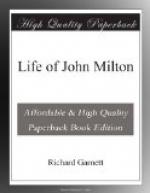“In
his rising seemed
A pillar of state; deep on
his front engraven
Deliberation sat, and public
care;
And princely counsel in his
face yet shone.”
Milton’s borrowings, nevertheless, nowise impair his greatness. The obligation is rather theirs, of whose stores he has condescended to avail himself. He may be compared to his native country, which, fertile originally in little but enterprise, has made the riches of the earth her own. He has given her a national epic, inferior to no other, and unlike most others, founded on no merely local circumstance, but such as must find access to every nation acquainted with the most widely-circulated Book in the world. He has further enriched his native literature with an imperishable monument of majestic diction, an example potent to counteract that wasting agency of familiar usage by which language is reduced to vulgarity, as sea-water wears cliffs to shingle. He has reconciled, as no other poet has ever done, the Hellenic spirit with the Hebraic, the Bible with the Renaissance. And, finally, as we began by saying, his poem is the mighty bridge—
“Bound with Gorgonian rigour not to move,”
across which the spirit of ancient poetry has travelled to modern times, and by which the continuity of great English literature has remained unbroken.
CHAPTER VIII.
In recording the publication of “Paradise Lost” in 1667, we have passed over the interval of Milton’s life immediately subsequent to the completion of the poem in 1663. The first incident of any importance is his migration to Chalfont St. Giles, near Beaconsfield, in Buckinghamshire, about July, 1665, to escape the plague then devastating London. Ell wood, whose family lived in the neighbourhood of Chalfont, had at his request taken for him “a pretty box” in that village; and we are, says Professor Masson, “to imagine Milton’s house in Artillery Walk shuttered up, and a coach and a large waggon brought to the door, and the blind man helped in, and the wife and the three daughters following, with a servant to look after the books and other things they have taken with them, and the whole party driven away towards Giles-Chalfont.” According to the same authority, Chalfont well deserves the name of Sleepy Hollow, lying at the bottom of a leafy dell. Milton’s cottage, alone of his residences, still exists, though divided into two tenements. It is a two-storey dwelling, with a garden, is built of brick, with wooden beams, musters nine rooms—though a question arises whether some of them ought not rather to be described as closets; the porch in which Milton may have breathed the summer air is gone, but the parlour retains the latticed casement at which he sat, though through it he could not see. His infirmity rendered the confined situation less of a drawback, and there are abundance of pleasant lanes, along which he could be conducted in his sightless strolls:—




